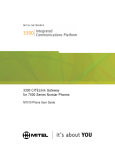Download Mitel 5220 IP User guide
Transcript
USER GUIDE 3300 ICP - 7.0 Contents 1 ABOUT YOUR PHONE Using the 5220 IP Phone in Remote Mode About Feature Access Codes For Users on Resilient 3300 ICP Systems 3 3 3 TIPS FOR YOUR COMFORT AND SAFETY 4 Don't cradle the handset! Protect your hearing Adjusting the viewing angle 4 4 4 5 CUSTOMIZING YOUR PHONE Ringer Control Handset Receiver Volume Control Speaker Volume Control Display Contrast Control Feature Keys Language Change 5 5 5 5 6 6 7 MAKING AND ANSWERING CALLS Make a call Answer a call Emergency Calls Phonebook Redial Redial - Saved Number Speed Call Keys Speed Call - Personal Handsfree Operation Auto-Answer Group Listen 7 7 8 9 10 10 11 12 13 14 14 -i- 15 CALL HANDLING Hold Transfer Conference Conference Split Add Held Swap Call Forward Call Forward - Remote Call Forward - End Chaining Call Forward - Forced Call Forward - Override Messaging - Advisory Messaging - Callback Messaging - Cancel Callback Messaging - Cancel All Callbacks 15 15 16 16 16 16 17 18 18 19 19 19 20 21 21 22 USING ADVANCED FEATURES Account Codes Attendant Call Hold - Remote Retrieve Call Park Call Pickup Campon Do Not Disturb Override Paging Direct Paging Reminder Headset Operation Headset Operation (with Feature Control Switch) Music Group Paging / Meet Me Answer Trunk Flash Record a Call Hot Desking Call History Tag Call -ii- 22 22 23 24 24 24 25 25 26 27 27 28 28 29 29 30 31 32 33 34 USING THE LINE INTERFACE MODULE Making and Answering Calls Using the Analog key Making and Answering Calls Using the Failover Mode -iii- 35 36 ABOUT YOUR PHONE The MITEL NETWORKS 5220IP phone has ten fixed-function keys ( SUPERKEY, TRANS/CONF, REDIAL, MESSAGE, HOLD, CANCEL, SPEAKER, MICROPHONE, , ), three softkeys, and 14 personal keys with built-in status indicators. The personal key on the bottom right is always your Prime Line; the remaining personal keys can be programmed as: z z z Feature keys (for example, Swap). You can program feature keys from your phone or using the Desktop Tool. Your administrator can also program feature keys. Speed Call keys. You can program speed call keys from your phone, or using the Desktop Tool. Line Appearances. Only the administrator can program line appearances. Note: For more information on the Desktop Tool, talk to your system administrator. Your phone also features display-assisted selection of features, on-hook dialing, and a large Message Indicator. Note: When using the SuperKey, press Cancel to back up one menu level. -1- 1. 2. 3. 4. 5. 6. Display Message Waiting Indicator Softkeys Fixed-Function Keys Volume Control Programmable Feature Keys -2- IMPORTANT NOTE FOR HEADSET USERS: Mitel Networks Headsets with Feature Control Switch must be installed in the dedicated headset jack (the jack nearest the front of the set). Installation will disable your handset microphone. Disconnecting the headset at the jack or at the quick-disconnect plug restores handset operation. Telephone status indicators When line is the indicator is Idle Off Busy On Ringing Flashing slowly On hold at your phone Flashing rapidly On hold at another phone Flashing slow on/fast off Using the 5220 IP Phone in Remote Mode Remote Mode allows the 5220 IP Phone to be used in the home or in other locations away from the office. For information on how to program the 5220 IP Phone for remote operation, refer to the Remote IP Phones Guide available at www.mitel.com About Feature Access Codes Use of some features requires dialing access codes. The codes are flexible and may be different than those in this guide. Ask your Administrator for a list of codes you should use. For Users on Resilient 3300 ICP Systems If during a call, you hear two beeps repeated every 20 seconds it means that your phone is switching to a secondary 3300 ICP system. The call continues and there is a change in the operation of some keys and features on your phone. Normal operation resumes when your phone switches back to the primary system. If your phone is idle and switched to the secondary system, you'll see a flashing rectangle on the display. The rectangle remains until the switch to the primary system is complete. -3- TIPS FOR YOUR COMFORT AND SAFETY Don't cradle the handset! Prolonged use of the handset can lead to neck, shoulder, or back discomfort, especially if you cradle the handset between your ear and shoulder. If you use your phone a lot, you may find it more comfortable to use a headset. See the section on headset usage elsewhere in this guide for more information. Protect your hearing Your phone has a control for adjusting the volume of the handset receiver or headset. Because continuous exposure to loud sounds can contribute to hearing loss, keep the volume at a moderate level. Adjusting the viewing angle The stand built into your phone tilts to give you a better view of the keys. To tilt your phone for better viewing: 1. Press the release tabs on thes sides of the stand. 2. Hinge the two front hooks and snap the two back hooks of the stand into either the upper or lower notches on the back of the phone. -4- CUSTOMIZING YOUR PHONE Ringer Control To adjust the Ringer Volume while the phone is ringing: z Press , . To adjust the Ringer Pitch while the phone is idle: 1. 2. 3. 4. 5. 6. Press Press Press Press Press Press SUPERKEY. the No softkey until "Ringer Adjust?" appears. the Yes softkey. the Yes softkey. , . SUPERKEY. Handset Receiver Volume Control To adjust the Handset Receiver Volume when you are using the handset: z Press , . Speaker Volume Control To adjust the Speaker Volume when making an on-hook call or when listening to background music: z Press , . Display Contrast Control To adjust the Display Contrast while your phone is idle: z , . -5- Feature Keys You can use the SUPERKEY on your phone or the Desktop Tool to program the personal keys. The Desktop Tool is a browser-based interface that makes programming quick and easy. For more information on using the Desktop Tool, please contact your System Administrator. To display information about a key: 1. Press SUPERKEY. 2. Press a personal key or REDIAL. 3. Press SUPERKEY. To re-program a personal key: 1. 2. 3. 4. 5. 6. 7. 8. Press Press Press Press Press Press Press Press SUPERKEY. the No softkey until "Personal Keys?" appears. the Yes softkey. a personal key that isn't a line key. the Change softkey. the No softkey until the desired feature appears. the Yes softkey. SUPERKEY. Language Change To change the display language: 1. 2. 3. 4. 5. 6. Press Press Press Press Press Press SUPERKEY. the No softkey until "Language?" appears. the Yes softkey. the Change softkey. the No until the desired language appears. the Yes softkey. -6- MAKING AND ANSWERING CALLS Make a call 1. Lift the handset. 2. If you want to use a Non-Prime Line, press a Line Appearance key. 3. Dial the number, -ORPress a Speed Call key. -ORPress REDIAL. Answer a call z Lift the handset. -ORPress the flashing Line appearance key and lift the handset. -7- Emergency Calls Warning for emergency number dialing: Consult your local authorities for Emergency Numbers and 911 or equivalent service availability in your area. There are two methods of dialing emergency numbers, based on the programming of your 3300 ICP: z z Emergency Call Routing NOT programmed Emergency Call Routing programmed Caution: Verify with your System Administrator which type of emergency number dialing you can use. EMERGENCY CALLS WHEN EMERGENCY CALL ROUTING NOT PROGRAMMED If Emergency Call Routing is NOT programmed, Emergency Number dialing should only be performed by picking up the handset and selecting the Line Interface Module key you have programmed. If Privacy Mode is enabled and the Line Interface Module key local line is busy, dialing will not occur on the Line Interface Module line. Emergency dialing using an IP connection may not be supported due to ICP system configuration and country location. For more information, contact your System Administrator. To make an Emergency Call using the Line Interface Module line: 1. Lift the handset. 2. Press the Line Interface Module key that you have programmed. The set indicates IP FAIL: ANALOG CALL 3. Dial your Local Emergency Number. -8- To make an Emergency Call using the Line Interface Module line, when the IP connection has failed: 1. Lift the handset. 2. Press the Line Interface Module key that you have programmed. The set indicates IP FAIL: ANALOG CALL. 3. Dial your Local Emergency Number. EMERGENCY CALLS WHEN EMERGENCY CALL ROUTING PROGRAMMED Note: This procedure is in addition to the methods described above. To make an Emergency Call if Emergency Call Routing is programmed: 1. Lift the handset. 2. Dial your Local Emergency Number (911 or equivalent). For more information on using the Line Interface Module line, refer to Using the Line Interface Module. Phonebook For each letter in the last name, press the appropriate key on the keypad until the letter is shown in the display; for example, if the letter C is required, softkey to correct errors. If the next press the digit 2 three times. Use the letter in a name is on the same key as the previous letter, press the softkey before proceeding. If required, use the softkey to add a space between the first and last name. To use Phonebook: 1. 2. 3. 4. 5. 6. Press the Phonebook softkey. Enter the last name of the desired party. Press the Lookup softkey. If no match exists, edit the original entry. If the name is not unique, press the Next softkey. Do one of the following: To make the call, press the Call softkey. To edit the entry, press the Retry softkey. To exit, press SUPERKEY. -9- Redial To redial the last number that you manually dialed: 1. Lift the handset. 2. Press REDIAL. Redial - Saved Number To save the last number that you manually dialed: 1. Lift the handset. 2. Dial **79. To Redial a saved number: 1. Lift the handset. 2. Dial *6*. -10- Speed Call Keys You may use Speed Call Keys to make a call or to send a string of digits during a call (press a Speed Call Key during a call to send a multi-digit password, for instance). To dial a stored Speed Call number: 1. Lift the handset. 2. Press a Speed Call key. To store a Speed Call number: 1. 2. 3. 4. 5. 6. 7. Press SUPERKEY. Press the No softkey until "Personal Keys?" appears. Press the Yes softkey. Press a personal key that isn`t a line key. Press the Change softkey. Press the Yes softkey. Do one of the following: To enter a new number, dial the number. Press HOLD between digits to create a pause during dialing; press HOLD more than once to lengthen the pause. To enter a trunk flash, press TRANS/CONF. (See "Trunk Flash" for more information about the use of this feature.) To enter the last number dialed, press REDIAL. 8. If you want the number to be private, press the Priv softkey. 9. Press the Save softkey. 0. Press SUPERKEY. -11- Speed Call - Personal To dial a stored personal Speed Call number: 1. Lift the handset. 2. Dial *58. 3. Enter an index number between 00 and 09. To store a personal Speed Call number: 1. 2. 3. 4. Lift the handset. Dial *67. Enter an index number between 00 and 09. Dial the number to be stored (press Hold between digits to create a pause during dialing - press Hold more than once to lengthen the pause). 5. Hang up. -12- Handsfree Operation To use Handsfree Operation to make calls: 1. If you want to use a Non-Prime Line, press a Line Appearance key. 2. Dial the number. 3. Communicate by using the speaker and the microphone. To use Handsfree Operation to answer calls: 1. Press the flashing line key. 2. Communicate by using the speaker and the microphone. To hang up while using Handsfree Operation: z Press SPEAKER. To temporarily disable the microphone during Handsfree Operation: z Press MICROPHONE (the microphone LED turns off). To re-enable the microphone and return to the conversation: z Press MICROPHONE (the microphone LED turns on). To disable Handsfree Operation: z Lift the handset. To return to Handsfree Operation: 1. Press SPEAKER. 2. Hang up. -13- Auto-Answer To enable or disable Auto-Answer: 1. Press SUPERKEY. 2. Press the No softkey until "Auto Answer?" appears. 3. Do one of the following: To enable Auto-Answer, press the TurnOn softkey. To disable Auto-Answer, press the TurnOff softkey. To answer a call when you hear ringback: z Communicate by using the speaker and the microphone. To terminate a call: z Press CANCEL. -ORWait for the caller to hang up. Group Listen With Group Listen you can carry on a conversation using the handset or headset while allowing others nearby to listen to the person at the far end over the handsfree speaker in your phone. While Group Listen is active, the handsfree microphone in your phone is turned off. To allow others in the room to listen to the far end of your call: z Press the Group Listen feature key. To return to a private two-way call from Group Listen: z Press the Group Listen feature key. To change a Group Listen call into a Handsfree call so that others in the room can join the conversation: 1. Press SPEAKER. 2. Hang up the handset. -14- CALL HANDLING Hold To place a call on Hold: z Press Hold. To retrieve a call from Hold: 1. Lift the handset. 2. Press the flashing line key. To retrieve a call from Hold at another station: z Press the flashing line key. -ORDial **1 and the number of the station that placed the call on Hold. Transfer To Transfer an active call: 1. Press TRANS/CONF. 2. Dial the number of the third party. 3. Do one of the following: To complete the Transfer, hang up. To announce the Transfer, wait for an answer, consult, and hang up. To cancel the Transfer, press CANCEL. To transfer an active call during headset operation: 1. Press TRANS/CONF. 2. Dial the number of the third party. 3. To complete the Transfer, press the Release feature key. -15- Conference To form a Conference when a two-party call is already in place, or to add another party to an existing Conference: 1. 2. 3. 4. Press TRANS/CONF. Dial the number of the next party. Wait for an answer. Press TRANS/CONF. To leave a Conference: z Hang up. Conference Split To Split a Conference and speak privately with the original party: z Press the Split softkey. Add Held To move a call on Hold to another line appearance: 1. Press the available line key. 2. Press the Addheld softkey. 3. Press the flashing line key. To add a call on Hold to an existing conversation or conference: 1. Press the Addheld softkey. 2. Press the flashing line key. Swap To call another party when you are in an established two-party call: 1. Press TRANS/CONF. 2. Dial the number. To alternate between the two parties: z Press the Trade softkey. -16- Call Forward Call Forward lets you redirect incoming calls to an alternate number. Always redirects all incoming calls regardless of the state of your phone. B-Int redirects internal calls when your phone is busy, and B-Ext redirects external calls when your phone is busy. NA-Int redirects internal calls after several rings if you don't answer, and NA-Ext redirects external calls after several rings if you don't answer. Note: For information about "I'm Here?", see Call Forward - Remote. To program Call Forward: 1. 2. 3. 4. 5. 6. 7. 8. 9. Press SUPERKEY. Press the No softkey until "Call Forwarding?" appears. Press the Yes softkey. Press the Next softkey until the type of Call Forward appears (see above). Press the Review softkey. If a number is already programmed, press the Change softkey. Press the Program softkey. Dial the destination number. Press the Save softkey. To turn Call Forward on and off (once it has been programmed): 1. 2. 3. 4. 5. 6. 7. Press SUPERKEY. Press the No softkey until "Call Forwarding?" appears. Press the Yes softkey. Press the Next softkey until the type of Call Forward appears. Press the Review softkey. Press the Change softkey. Do one of the following: To turn Call Forward on, press the TurnOn softkey. To turn Call Forward off, press the TurnOff softkey. -17- Call Forward - Remote To forward calls from a remote station to your current location: 1. 2. 3. 4. 5. 6. 7. Press SUPERKEY. Press the No softkey until "Call Forwarding?" appears. Press the Yes softkey. Press the Next softkey until "I Am Here" appears. Press the Yes softkey. Dial the extension of the remote station. Press the Save softkey. To cancel Call Forward - Remote from the station that set the remote forwarding: 1. 2. 3. 4. Lift the handset. Dial **77. Dial the extension of the remote station. Hang up. To cancel Call Forward - Remote from the station that was forwarded: 1. 2. 3. 4. 5. 6. 7. Press Press Press Press Press Press Press SUPERKEY. the No softkey until "Call Forwarding?" appears. the Yes softkey. the Review softkey. the Change softkey. the TurnOff softkey. SUPERKEY. Call Forward - End Chaining To ensure that calls do not get forwarded again by the destination number: 1. Lift the handset. 2. Dial 64. 3. Hang up. To again allow calls to be forwarded by the destination number: 1. Lift the handset. 2. Dial **73. 3. Hang up. -18- Call Forward - Forced To force an incoming call to be forwarded: z Press the Forward softkey. Call Forward - Override To override Call Forward and ring a station: 1. Lift the handset. 2. Dial *1*. 3. Dial the extension number. Messaging - Advisory To turn Messaging - Advisory on: 1. 2. 3. 4. 5. Press Press Press Press Press SUPERKEY. the No softkey until "Advisory Msgs?" appears. the Yes softkey. the Next softkey until the desired message appears. the TurnOn softkey. To turn Messaging - Advisory off: 1. 2. 3. 4. Press Press Press Press SUPERKEY. the No softkey until "Advisory Msgs?" appears. the Yes softkey. the TurnOff softkey. -19- Messaging - Callback To leave a message waiting indication on a phone when you hear busy or ringback tone: z Press MESSAGE or the Callback softkey. To respond to a message waiting condition on your phone: 1. Press MESSAGE. 2. If a password is required, dial your password and press the Enter softkey. 3. Press the Yes softkey. 4. Do one or all of the following (if required): To display the time the message was sent, press the More softkey. To display the number of the caller, press the More softkey twice. 5. Do one of the following: To call the message sender, press the Call softkey. To delete the message, press the Erase softkey. To view the next message, press MESSAGE. To check for messages from a remote station: 1. 2. 3. 4. 5. 6. Press SUPERKEY. Press the No softkey until "Remote Msging?" appears. Press the Yes softkey. Dial your extension number. Press the Enter softkey. If a password is required, enter your password and press the Enter softkey. 7. Press the Yes softkey. -20- To set, change, or clear a password (up to 7 digits, not including 0): 1. 2. 3. 4. 5. 6. 7. 8. 9. Press SUPERKEY. Press the No softkey until "Set Password?" appears. Press the Yes softkey. Do one of the following: To enter a new password, enter your password. To change or clear your password, enter your current password. Press the Enter softkey. If you are changing or clearing your password, do one of the following: To change your password, enter your new password and press the Enter softkey. To clear your password, enter 0. Enter your new password again. If you are setting up or changing a password, press the Enter softkey. Press SUPERKEY. Messaging - Cancel Callback To cancel a Callback: 1. 2. 3. 4. Lift the handset. Dial *1#. Dial the number of the called station. Hang up. Messaging - Cancel All Callbacks To cancel all Callbacks: 1. Lift the handset. 2. Dial #1. 3. Hang up. -21- USING ADVANCED FEATURES Account Codes To use Forced Account Codes: 1. Lift the handset. 2. Dial the Account Code digits. 3. Press #. To enter an Account Code during a call: 1. 2. 3. 4. 5. Press SUPERKEY. Press the Yes softkey. Dial the Account Code digits. Press the Save softkey. Do one of the following: For a verified account code, press the Yes softkey. For a non-verified account code, press the No softkey. Attendant Call Hold - Remote Retrieve To retrieve a call placed on Hold by the attendant: 1. Lift the handset. 2. Dial *23. 3. Dial the digits announced by the attendant. -22- Call Park The Call Park feature allows you to place a call in a special hold state. You, or someone else, can then retrieve the call from any extension in the system. After parking the call, the system can automatically connect you to paging equipment so that you can announce the call to the requested party. To park an active call: 1. Do one of the following: Press the Call Park feature key (must be programmed) Press TRANS/CONF, and then dial *7#. The display shows PARKED@, followed by the park destination and parking spot index (if applicable). Example: PARKED@ 1234 @ 02. 2. Dial the directory number on which to park the call (not required if the number is programmed to the Call Park feature key). 3. To inform a user that a parked call is waiting, do one of the following: If automatic paging is enabled, announce the call and the park retrieve digits shown on the display. If automatic paging is disabled, press the programmed Page key, or dial **9, followed by the Paging zone number (if required). Then, announce the call and park retrieve digits shown on the display. Note: Paging over a loudspeaker is not permitted in handsfree mode; you must use the handset or headset. To retrieve a parked call: 1. Do one of the following: Dial *8#. Press the Call Park - Retrieve feature key (must be programmed). 2. Dial the directory number on which the call is parked (not required if the number is programmed to the Call Park feature key). 3. If there are multiple calls parked on the number, dial the two-digit index number to retrieve a specific call, or # to retrieve the longest parked call. -23- Call Pickup To answer a call that is ringing at another station in your Pickup Group: 1. Lift the handset. 2. Press the Pickup softkey. To answer a call that is ringing at a station not in your Pickup Group: 1. Lift the handset. 2. Dial **6. 3. Dial the number of the ringing station. Campon To Campon to a busy station: z Press the Wait softkey. To retrieve a call when you hear Campon tone: z Press the Trade softkey. Do Not Disturb To activate or deactivate Do Not Disturb: z Press the Do Not Disturb feature key. To activate Do Not Disturb from a remote station: 1. 2. 3. 4. Lift handset. Dial **5. Dial the number of the station to which Do Not Disturb is to apply. Hang up. To deactivate Do Not Disturb from a remote station: 1. 2. 3. 4. Lift handset. Dial ##5. Dial the number of the station with Do Not Disturb activated. Hang up. -24- Override To use Override when you encounter busy or DND tone: z Press the Intrude feature key. Paging To use Paging: 1. 2. 3. 4. Lift handset. Press the Pager feature key. Dial the Paging zone number (if required). Make the announcement. -25- Direct Paging Direct Paging allows you to page a party through their phone speaker. If the paged party has Off-Hook Voice Announce enabled, the page will be heard even when the party is on a handset or headset call. To page a party: 1. 2. 3. 4. Lift the handset. Press the Direct Paging feature key. Dial the extension number. Speak to the dialed party after the tone. If Handsfree Answerback has been turned on at your phone and you receive a Direct Page while your phone is idle, or while you are on a handset of headset call, a handsfree call will automatically be established after a single burst of tone. The following instructions assume that Handsfree Answerback is not enabled on your phone. To answer a Direct Page (indicated by a single burst of tone): z Lift handset. - OR Press MICROPHONE. To answer a page while using the handset: z Press MICROPHONE. To enable or disable Handsfree Answerback: z Press MICROPHONE while the phone is idle. -26- Reminder To program a Reminder: 1. 2. 3. 4. 5. Press Press Press Enter Press SUPERKEY. the No softkey until "Timed Reminder?" appears. the Yes softkey. the time in 24-hour format. the Save softkey. To view, change, and/or cancel a pending Reminder: 1. 2. 3. 4. Press SUPERKEY. Press the No softkey until "Timed Reminder?" appears. Press the Yes softkey. Do one of the following: To change the Reminder, press the Change softkey, enter the new time, and press the Save softkey. To cancel the Reminder, press the Clear softkey. To exit without canceling the Reminder, press SUPERKEY. To acknowledge a Reminder when your phone rings once: z Press the Confirm softkey. Headset Operation To enable Headset Operation: z Press the Headset feature key. To answer a call (when Auto Answer is disabled): z Press the flashing line key. To hang up: z Press CANCEL. To disable Headset Operation: z Press the Headset feature key. -27- Headset Operation (with Feature Control Switch) IMPORTANT NOTE: Mitel Networks Headsets with Feature Control Switch must be installed in the dedicated headset jack (the jack nearest the front of the phone). Installation will disable your handset microphone. Disconnecting the headset at the jack or at the quick-disconnect plug restores handset operation. If handset operation is required for an extended period of time, you should press the Headset feature key to return the phone to handset mode. To enable Headset Operation: z Press the Headset feature key. To answer a call: z Press flashing Line Appearance key -ORQuickly press and release the headset's feature control switch. To mute the headset microphone: z Press and hold the headset's feature control switch. To hang up: z Press CANCEL. -ORQuickly press and release the headset's feature control switch. To disable Headset Operation: z Press the Headset feature key. Music To turn Music on and off when the phone is idle: 1. Press SUPERKEY. 2. Press the No softkey until "Music?" appears. 3. Do one of the following: To turn the music on, press the TurnOn softkey. To turn the music off, press the TurnOff softkey. 4. Press SUPERKEY. -28- Group Paging / Meet Me Answer Group Paging allows you to page a group of phones through their built-in speakers. You can belong to to as many as three paging groups with one group designated as your "prime" group. When you need to respond to a Group Page but don't know the identity or extension number of the paging party, use the Meet Me Answer feature. You have up to 15 minutes after receiving the page to use Meet Me Answer. To make a Group Page: 1. Lift the handset. 2. Press Direct Page or dial *37. 3. Do one of the following: To page your prime page group, press #. To page a specific page group, dial the page group directory number. 4. Speak to the dialed party after the tone. To respond to a Group Page by using Meet Me Answer: 1. Lift handset. 2. Dial *88. 3. Do one of the following: To respond to a page from your prime page group, press #. To respond to a page from a specific page group, dial the page group directory number. Trunk Flash The Trunk Flash feature allows you to access Centrex features (if available) while you are talking on an outside call. To flash a trunk while talking on an outside call: 1. 2. 3. 4. Press TRANS/CONF. Dial *57 for a single flash or *56 for a double flash. Wait for dial tone. Dial the Centrex feature access code. -29- Record a Call This feature uses your voice mail system to record your phone conversations. Note: You may be required by law to inform the other party that you are recording the conversation. For specific instructions, consult your system administrator. To start recording while on a two-party call: z Press the Record Call key. (See Feature Keys elsewhere in this guide for instructions on programming a Record Call key to your phone.) Note: Your system may be programmed to automatically begin recording external calls when you or the other answers. To pause recording: z Press the Pause softkey. To resume recording after pausing: z Press the Resume softkey. To stop a recording without saving it: z Press the Stop&Erase softkey. To stop and save a recording: z Press the Stop&Save softkey. Putting the call on hold saves the recording; taking the call off hold starts a new recording. Depending on system programming, hanging up, or pressing TRANS/CONF or a DSS key, may also save the recording. To listen to a recording: 1. Lift the handset. 2. Access your voice mailbox. 3. Follow the prompts to retrieve the recording. -30- Hot Desking Hot Desking allows you to log into the telephone system from any phone designated as a Hot Desk phone. Simply log in at the phone using your assigned Hot Desk User Extension Number and the phone immediately assumes all your speed dials, features keys, call forwarding setup, and line appearances - even your language preference for the display. Any changes you make to the phone while you are logged in--for example, adding a speed dial--are saved to your personal profile. Logging in activates your profile on any phone that supports Hot Desking. Note: All Hot Desking profiles have 13 programmable keys. If you log into a phone that has a fewer number of keys, the extra ones are "hidden". Only the use of the extra keys is lost, not the features assigned to them. To log into a Hot Desking phone (the phone must be idle): 1. 2. 3. 4. Press Press Enter Press the HotDesk softkey. the Login softkey. your Hot Desk User Extension Number the OK softkey. To log out of Hot Desking phone (the phone must be idle): 1. Press the HotDesk softkey. 2. Press the Logout softkey. 3. Press the Confirm sofkey. Note: Your profile can only be active on one phone at a time. If you log in from another phone without logging out from the first one, the system will automatically deactivate your profile on the first phone. Hot Desk Remote Logout A user that has forgotten to log out of a Hot Desking phone can be logged out using any phone that supports Hot Desk Remote Logout. To remotely log out a Hot Desking phone: 1. Dial 111. 2. Dial the Hot Desk User Extension Number that you want to log out. -31- Call History Call History keeps track of the names (if available) and telephone numbers of missed calls, answered incoming external calls, and outgoing external calls. Once enabled on your phone by your system administrator, it functions automatically. To display the call history, and view call detail: 1. Press the Call History feature key. The total number of missed calls is displayed in brackets ( ), the number of new missed calls is indicated with a *. 2. To browse though the list of missed calls, press the Yes softkey, followed by the UP and DOWN keys to scroll through the list. To view answered or outgoing calls, press the No softkey (once for answered, twice for Outgoing). Use the UP and DOWN keys to scroll through the list of answered or outgoing calls. 3. To view the number of the call, press the Detail softkey while the call record is displayed. Pressing the Next softkey displays the time and date. To return a call: 1. Display the call you want to return. 2. Do one of the following: If the call is internal, and the caller name is known, press the Call softkey. For unknown numbers, the Call softkey is not displayed. If the call is external, and you normally need to precede external calls with a digit such as 9, its likely that your system administrator has programmed your system to insert the 9 for you. In this case, pressing the Call softkey initiates the call immediately. Sometimes the system will be unable to complete the dialing automatically. When this happens, you are prompted to edit the dialed digits manually by placing a flashing cursor at the first digit position, using the --> softkey icon in the middle of the display. Use the --> softkey to move the cursor to the appropriate digit and press Clear to delete the digit. When you have deleted the required digits, type the correct digits to replace them. When you have the dial string edited to suit your needs, press the Call softkey to dial the number. -32- To delete all missed, answered, or outgoing call logs: 1. After selecting the type of logs you wish to delete, press the DeleteAll softkey. 2. Confirm that you do want to delete all items by pressing the Yes softkey. To delete a particular call from the call log: z With the call log that you want to delete displayed, press the Delete softkey. Tag Call Tag Call allows you to signal that you are the victim of a threatening or malicious call. Using the tag, your system administrator or telephone company can identify the source of the call and provide this information to appropriate personnel or authorities. CAUTION: Tagging a non-malicious call may result in fines or other penalties. To tag a malicious call: z z z Press the Tag Call feature key while the call is in progress. See "Feature Keys" elsewhere in this guide for information on programming a Tag Call feature key to your phone. -ORPress TRANS/CONF. Dial *55. If the call was successfully tagged "Thank You" is shown on the display; otherwise, "Not Allowed" is displayed. Note: Tag Call can be used on active two-party calls only. Calls on hold and conference calls cannot be tagged. -33- USING THE LINE INTERFACE MODULE The 5220 IP Phone supports the Mitel Line Interface Module. The Line Interface Module allows you to make and receive calls over an analog line (Line Interface Module line) connected to your phone. The Line Interface Module operates in either of the following two modes, as determined by your System Administrator: z z Line Interface Module Mode: your phone allows you to use the Line Interface Module line at any time Failover Mode: you can use the Line Interface Module line only when the IP connection has failed Note: Handsfree and on-hook dialing are not supported on the Line Interface Module line. For information on emergency number dialing using the Line Interface Module, refer to Emergency Calls. -34- Making and Answering Calls Using the Analog key To make a call using the Analog line: 1. Lift the handset. 2. Press the key you programmed as Line Interface Module. ANALOG CALL is displayed. 3. Dial the number. Note: When you make an external call over the analog line, a prefix dialing number is not required. If your phones Line Interface Module key has the Privacy option enabled, you cannot access the analog line when another phone is using the analog line (key is solid orange).To access the analog line, the user of the other phone must first hang up. To determine whether the Privacy option is enabled, contact your System Administrator. To answer a Call using the analog line: 1. Lift the handset. 2. Press the Line Interface Module key that is highlighted. To answer a waiting call on the analog line: Note: If you have subscribed to an analog call waiting service, you may use the hookswitch or press CANCEL to answer a waiting analog call. When you are on an analog call and a waiting analog call arrives, you hear a beep. This feature may not be supported in all regions. To answer a waiting analog call or return to the original analog call: 1. Do one of the following: Press and release the hookswitch Press CANCEL 2. Press the key you have programmed as Line Interface Module. To put a current call on hold to answer an incoming analog call: z Press the highlighted Line Interface Module key. -35- To switch between the current call and the held call when one of the calls is using the analog line, do one of the following: z z If your current call is using the analog line, press the flashing Line key of the held call. The analog call is automatically put on hold. If your current call is using an IP line, press the highlighted Line Interface Module key. The IP line is automatically put on hold. To end a current call when an incoming analog call arrives: z Press CANCEL, and then press the flashing Line Interface Module key. The current call ends and you are connected to the caller on the analog line. To end the current analog call when an incoming call arrives: z Press CANCEL. The current analog call ends and you are connected to the new caller. Making and Answering Calls Using the Failover Mode To make a call using the analog line during an IP connection failure: 1. Lift the handset. The phone displays IP FAIL: ANALOG CALL. 2. Dial the number. To answer a call using the analog line during an IP connection failure: z Lift the handset. The call is answered. The phone displays IP FAIL: ANALOG CALL. -36- TM, ® Trademark of Mitel Networks Corporation. © Copyright 2006, Mitel Networks Corporation. All rights reserved.




















































